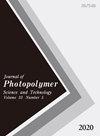Synthesis, Properties, and Photovoltaic Characteristics of Arch- and S-shaped Naphthobisthiadiazole-based Acceptors
IF 0.7
4区 化学
Q4 POLYMER SCIENCE
Journal of Photopolymer Science and Technology
Pub Date : 2021-06-11
DOI:10.2494/photopolymer.34.285
引用次数: 1
Abstract
Fine-tuning physical properties by structural modification is important for developing organic semiconducting materials. In this work, we designed and synthesized new electron-accepting compounds containing or naphtho[1,2- c :5,6- c' ]bis[1,2,5]thiadiazole (NTz) groups as electron-accepting units; these units are structural isomers. The vNTz-based compounds have an arch-shaped molecular backbone with C 2v symmetry, whereas the NTz-based compound forms an S-shaped molecular backbone with C 2h symmetry. Property measurements showed unique behavior originating from the vNTz core. An organic solar cell comprising the vNTz-based compound and poly(3-hexylthiopehene) showed a power conversion efficiency of 2.06%. This result demonstrates the potential of vNTz as an electron-accepting unit in organic semiconducting materials.拱形和s型萘双噻二唑基受体的合成、性质和光伏特性
通过结构修饰来微调物理性质是开发有机半导体材料的重要手段。本文设计并合成了以萘[1,2- c:5,6- c']二[1,2,5]噻二唑(NTz)为电子接受单位的新型电子接受化合物;这些单位是结构异构体。vntz基化合物具有c2v对称的拱形分子骨架,而ntz基化合物具有c2h对称的s形分子骨架。性能测量显示了vNTz核的独特行为。由vntz基化合物和聚(3-己基噻吩)组成的有机太阳能电池的功率转换效率为2.06%。这一结果证明了vNTz在有机半导体材料中作为电子接受单元的潜力。
本文章由计算机程序翻译,如有差异,请以英文原文为准。
求助全文
约1分钟内获得全文
求助全文
来源期刊
CiteScore
1.50
自引率
25.00%
发文量
0
审稿时长
4-8 weeks
期刊介绍:
Journal of Photopolymer Science and Technology is devoted to the publication of articles on the scientific progress and the technical development of photopolymers.

 求助内容:
求助内容: 应助结果提醒方式:
应助结果提醒方式:


